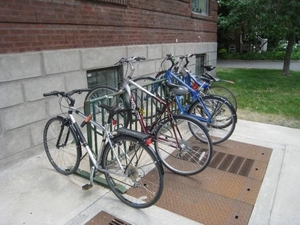How to protect your bike
Thieves are looking especially for the bikes that are left unlocked or locked inadequately.
Therefore learning to protect your bike is extremely important. How? Well, by:

Choosing the right lock
Be aware that not all bike locks are created equal, the tougher the better. U-locks and heavy-duty chain locks are harder to cut and therefore offer better protection.
A cable lock is not secure enough to be your only lock, as they are easy to cut with easily concealed tools; this is why bikes locked with cable locks get stolen very often.
However, you can use a cable lock to secure a wheel or seat to your U-lock.
Locking the right way
Your bike is most secure when the frame is locked directly to a solid stationary object, like a bike rack or tall metal post. You can improve your security when you also
loop your lock through one or both of your wheels.
Locking only to your wheel or any other part that can be removed easily (basket, rack, seat) leaves the rest of your bike extremely vulnerable.
Picking the right place
You know, visibility is the key to security, therefore locking your bike in a visible, central location, such as right near a busy building entrance, puts more eyes on your
bike, which discourages thieves. At night, that spot should be well-lit, too.
If you’re lucky, there’s a bike rack where you can leave your bike. If there isn’t one — or it’s not visible and central — then you better opt locking to a tall sign post or
metal fencing in a visible and central location.
Choosing the right bike rack
Not all bike rack styles offer enough security.
The most secure styles — the inverted U, A and post and loop styles, as well as the Stanford rack (designed at Stanford University) — let you to lock securely to your frame.
They also provide two points of contact for your frame, which provides stability as well.
You should be aware though that bikes left out overnight on the street, most of the time disappear or get dismantled, even when locked correctly with a strong lock to a secure rack. Of course there’s no way to adequately secure your bike overnight on the street, regardless which neighborhood you park in!
Unlocked bikes are the easiest ones to steal. Even where it might seem safe to leave your bike unlocked for just a second — for a really quick errand or to run over to say hi to a friend, etc... The truth is that’s all the time it takes for someone to grab your bike and leave.
Locking has to become a habit wherever you leave your bike unattended, even if it’s at home in a garage, on a porch or in your backyard. Also, don’t forget about locking up at a workplace that has any kind of public access.
Unfortunately no method is completely fail-safe. However there are two steps that can improve your chances of recovering your stolen bike, in case it happens:
1. Know your bike’s serial number
Law enforcement generally won’t look for a stolen bike, but they routinely discover stolen bikes in the course of their other work. When they do, they often look for the
bike’s serial number – that’s how they’d find you if they recovered your stolen bike. Therefore documenting your serial number is very important.
2. Promptly report a theft
Even if you may not think it’ll do any good, make sure to file a police report. Only few stolen bikes are in fact reported stolen, and when they are found, law enforcement has
no way to identify the owners of most of them. As a result, only a small percentage of recovered bikes get returned; that is the reason why making a theft report is key for
getting your bike back.
Have you ever experienced having your bike stolen? What are your methods to protect your bike?


If you already have an account, please LOGIN.
If not, you may consider creating on. It’s FREE!
» Login
» Sign up